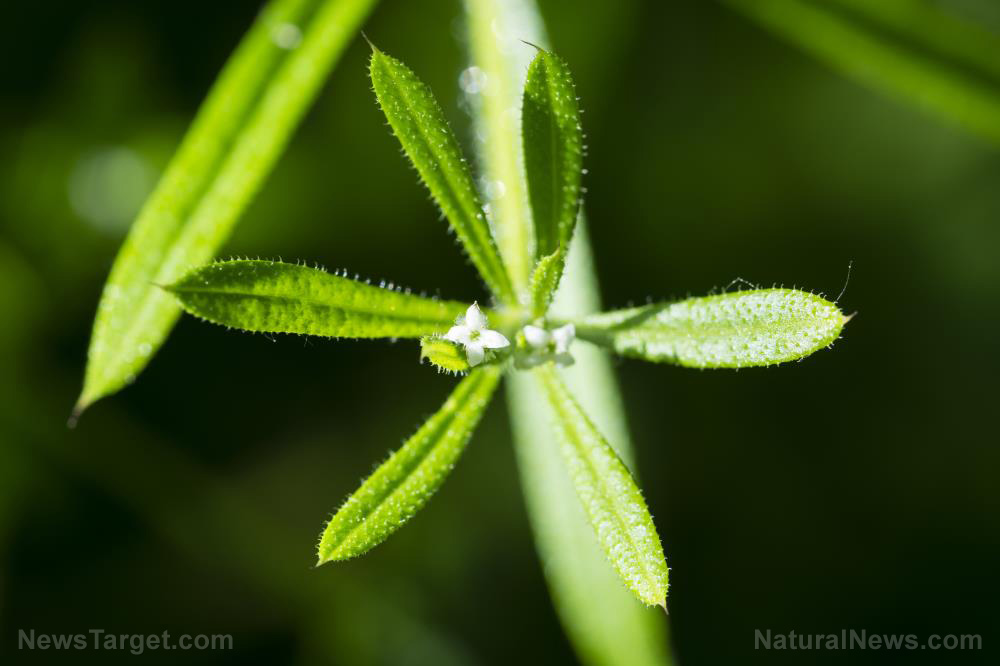Cleavers: A sticky superfood with a long history of medicinal use
06/05/2025 / By Ava Grace

- Cleavers (Galium aparine) has been used since ancient times by the Greeks and Romans for its diuretic and lymphatic properties. Medieval herbalists employed it for treating skin conditions, urinary tract infections and swelling. Native to Europe, Asia and North America, it thrives in temperate climates and is known by common names such as catchweed and sticky willy.
- Cleavers is rich in phytonutrients, including iridoids, flavonoids, tannins, chlorophyll and coumarins, which provide anti-inflammatory, antioxidant and detoxifying benefits. Cleavers can support lymphatic health, skin health, urinary function and digestion and helps reduce inflammation.
- Cleavers is widely used as a lymphatic tonic, skin remedy, diuretic, digestive aid and anti-inflammatory agent. Modern herbalists use it in tinctures, teas and topical preparations because of its healing properties.
- The young shoots and leaves of cleavers are edible, offering a mild, grassy flavor. It can be used in soups, salads, smoothies, pesto and herbal teas, making it a versatile ingredient in detoxifying and nutritious recipes.
- Cleavers is recognizable by its sticky, hooked hairs and slender stems with lance-shaped leaves. It has a mild, slightly sweet taste and holds cultural significance, such as in Irish folklore, where it was believed to ward off evil spirits and bring good luck.
In the world of herbal medicine, few plants are as versatile and intriguing as Galium aparine, commonly known as cleavers. This unassuming herb, with its velvety, sticky leaves and sprawling growth habit, has been a staple in traditional healing practices for centuries. From its historical uses to its modern-day applications, cleavers is a plant that deserves recognition for its remarkable health benefits and culinary potential.
Brief history of cleavers
Cleavers has a long and storied history, dating back to ancient times. The plant is believed to have been used by the ancient Greeks and Romans, who valued it for its diuretic and lymphatic properties.
The Greek physician Dioscorides, in his seminal work De Materia Medica, described cleavers as a natural remedy for skin conditions and swelling.
In medieval Europe, cleavers was used by herbalists to treat ailments ranging from urinary tract infections to skin irritations. (Related: Folk medicine plants from Mexico and Central America found to have anticancer potential.)
Native to Europe, Asia and North America, cleavers thrives in temperate climates and is often found in hedgerows, woodlands and along riverbanks. Its ability to cling to clothing and animal fur — thanks to the tiny hooked hairs on its stems and leaves — has earned it a variety of colorful names, such as catchweed, sticky willy and robin-run-the-hedge.
In Irish folklore, cleavers was believed to have protective properties. It was often hung over doorways to ward off evil spirits and bring good luck to the household. This tradition highlights the plant’s enduring cultural significance and its reputation as a guardian of health and well-being.
Cleavers is easily recognizable by its slender, square stems and whorls of narrow, lance-shaped leaves. The plant’s tiny white flowers bloom in spring and summer, adding a delicate charm to its otherwise rugged appearance. The leaves and stems are covered in fine, hooked hairs which give the plant its characteristic stickiness.
Phytonutrients and medicinal uses
Cleavers is a nutritional powerhouse and is packed with phytonutrients that contribute to its healing properties. Among its key compounds are:
- Iridoids, which are known for their anti-inflammatory and antioxidant effects
- Flavonoids, which are compounds that support cardiovascular health and combat oxidative stress
- Tannins, which have astringent properties that can help soothe irritated tissues
- Chlorophyll, which can support detoxification and promotes healthy blood circulation
- Coumarins, which are compounds that possess anticoagulant and anti-inflammatory effects
These phytonutrients work synergistically to make cleavers a potent herb for supporting overall health and wellness.
Cleavers has been traditionally used to address a wide range of health concerns. Its most well-known applications include:
- Lymphatic support – Cleavers is often referred to as a “lymphatic tonic” due to its ability to stimulate the lymphatic system, helping to detoxify the body and reduce swelling.
- Skin remedy – Cleavers’ anti-inflammatory and astringent properties make it effective for treating acne, eczema and minor wounds.
- Urinary support – Cleavers acts as a gentle diuretic, promoting healthy kidney function and alleviating conditions like urinary tract infections.
- Digestive aid – Cleavers’ mild laxative properties can help relieve constipation and support digestive health.
- Anti-inflammatory agent – Cleavers’ ability to reduce inflammation can help with conditions such as arthritis and gout.
Modern herbalists continue to use cleavers in tinctures, teas and topical preparations to harness its healing potential.
Culinary uses of cleavers
While cleavers is primarily known for its medicinal properties, it also has a place in the kitchen. The young shoots and leaves of cleavers can be eaten raw or cooked, offering a mild, grassy flavor reminiscent of spinach.
Here are a few recipe ideas that incorporate cleavers:
- Cleavers and spinach soup – A nourishing blend of cleavers, spinach and vegetable broth, perfect for detoxifying the body.
- Spring cleavers salad – Combine cleavers leaves with fresh greens, radishes and a light vinaigrette for a refreshing seasonal dish.
- Cleavers smoothie – Blend cleavers with bananas, apples and almond milk for a nutrient-packed green smoothie.
- Cleavers pesto – Substitute basil with cleavers for a unique twist on traditional pesto.
- Herbal cleavers tea – Steep fresh or dried cleavers in hot water for a soothing, detoxifying beverage.
In terms of taste, cleavers has a mild, slightly grassy flavor with a hint of sweetness. Its tender young shoots are the most palatable, making them ideal for culinary use. From its ancient use as a lymphatic tonic to its modern applications in skin care and detoxification, this sticky superfood continues to prove its worth.
Whether enjoyed in a soothing tea, a vibrant salad or a healing tincture, cleavers offers a wealth of benefits for those seeking to enhance their well-being naturally.
This story is not medical advice and is not intended to treat or cure any disease. Always consult with a qualified naturopathic physician for personalized advice about your specific health situation or concern.
Visit NaturalNews.com, a great article source where you can learn about superfoods and their health benefits.
You can also try Brighteon.ai, an AI model created by Mike Adams, also known as the Health Ranger. This model is available as a free download to be run locally and is designed to help share and decentralize knowledge. By doing so, it aims to bypass censorship and empower people with knowledge.
If you’re looking for an uncensored video free speech website where you can openly discuss nutrition, natural medicine, ingredients and more, check out Brighteon.com and our two free speech social media sites, Brighteon.IO and Brighteon.social.
Watch this video to learn about the medicinal benefits of cleavers.
This video is from the Holistic Herbalist channel on Brighteon.com.
More related stories:
Beyond antibiotics: How to build immunity and prevent infections with food and herbs.
From weeds to wellness: The hidden superfoods in your backyard.
Health Ranger Report: Exploring biblical foods and herbs for HEALING.
The power of dates: A sweet superfood from ancient times.
Sources include:
Submit a correction >>
Tagged Under:
alternative medicine, anti-inflammatory, cleavers, food cures, food is medicine, food science, functional food, health science, herbal medicine, Herbs, natural cures, natural healing, natural health, natural ingredients, natural medicine, organics, phytonutrients, plant medicine, remedies
This article may contain statements that reflect the opinion of the author
RECENT NEWS & ARTICLES
HealthScience.News is a fact-based public education website published by Health Science News Features, LLC.
All content copyright © 2018 by Health Science News Features, LLC.
Contact Us with Tips or Corrections
All trademarks, registered trademarks and servicemarks mentioned on this site are the property of their respective owners.



















